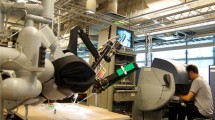Abstract
Background
One of the disadvantages of laparoscopic surgery is its decreased tactile feedback. Surgical experience compensates for the decline in the sense of touch due to an improved ability to process visual information. Stochastic resonance (SR) is known to improve tactile sensation. In this study, we sought to improve the tactile feedback in laparoscopic surgery using SR to safely perform laparoscopic surgery.
Methods
Ten surgeons (nine males and one female, age: 30–44 years, median age: 34) with the experiences of >50 laparoscopic surgeries volunteered to participate in this study. We tested the hypothesis that low-level noise applied to the hand can enhance the tactile sensation during surgery. We performed this experiment under three hand conditions (bare-handed conditions, gloved conditions and using the laparoscopic instrument with gloved hands). A piezoelectric actuator that generates vibrations was attached on the radial side of the participant’s index finger or to the grip of the laparoscopic instrument. Fine-touch tests were performed using the Semmes–Weinstein test kit. Moreover, we planned laparoscopic suturing and knot-tying tasks in the dry box and using an animal model under controlled vibrations.
Results
In the touch tests using bare hands, gloved hands and the laparoscopic instrument, the mean correct ratio was significantly lower than that observed in the test with no vibrations. Moreover, the OSATS scores for the laparoscopic suturing and knot-tying tasks showed significantly better scores with vibrations.
Conclusions
This technique has a potential to be a great help in establishing safer and high-quality laparoscopic procedures.








Similar content being viewed by others
References
Martin JA, Regehr G, Reznick R, Macrae H, Murnaghan J, Hutchison C, Brown M (1997) Objective structured assessment of technical skill (OSATS) for surgical residents. Br J Surg 84:273–278
Anastakis DJ, Regehr G, Reznick RK, Cusimano M, Murnaghan J (1999) Assessment of technical skill transfer from the bench training model to the human model. Am J Surg 177:167–170
Datta V, Mackay S, Chang A, Darzi A (2002) The relationship between motion analysis and surgical technical assessments. Am J Surg 184:70–73
Darzi A, Datta V, Mackay S (2001) The challenge for objective assessment of surgical skill. Am J Surg 181:484–486
Datta V, Mirren M, Mackay S, Chang A, Cheshire N, Darzi A (2002) Relationship between skill-based model. Surgery 131:318–323
Bann S, Datta V, Khan M, Darzi A (2003) The surgical error examination is a novel method for objective technical knowledge assessment. Am J Surg 185:507–511
Francis NK, Hanna GB, Cuschieri A (2002) The performance of master surgeons on the advanced Dundee endoscopic psychomotor tester: contrast validity study. Arch Surg 137:841–844
Egi H, Okajima M, Yoshimitsu M, Ikeda S, Miyata Y, Masugami H, Kawahara T, Kurita Y, Kaneko M, Asahara T (2008) Objective assessment of endoscopic surgical skills by analyzing direction-dependent dexterity using the Hiroshima University Endoscopic Surgical Assessment Device (HUESAD). Surg Today 38:705–710
Egi H, Okajima M, Kawahara T, Yoshimitsu M, Sumitani D, Tokunaga M, Takeda H, Itamoto T, Ohdan H (2008) Scientific assessment of endoscopic surgical skills. Minim Invasive Ther Allied Technol 19:30–34
Tokunaga M, Egi H, Hattori M, Yoshimitsu SumitaniD, Kawahara T, Okajima M, Ohdan H (2012) Approaching time is important for assessment of endoscopic surgical skills. Minim Invasive Ther Allied Technol 21:142–149
Dhruv NeelT, Niemi JamesB, Harry JasonD, Lipsitz LewisA, Collins JamesJ (2003) Enhancing tactile sensation in older adults with electrical noise stimulation. NeuroReport 13:597–600
Khaodhiar Lalita, Lima Christina, Niemi JamesB, Harry JasonD, Earnest Russell, Veves Aristidis (2003) Enhancing sensation in diabetic neuropathic foot with mechanical noise. Diabetes Care 26:3280–3282
Harada N, Griffin MJ (1991) Factors influencing vibration sense thresholds used to assess occupational exposures to hand transmitted vibration. Br J Ind Med 48:185–192
Gescheider GA, Bolanowski SJ, Pope JV, Verillo RT (2002) A four-channel analysis of the tactile sensitivity of the fingertip: frequency selectivity, spatial summation, and temporal summation. Somatosens Mot Res 19:114–124
Acknowledgments
This study was partially funded by the Japanese Society for the Promotion of Science.
Disclosures
Drs. Hiroyuki Sawada, Hiroyuki Egi, Minoru Hattori, Takahisa Suzuki, Shoichiro Mukai, Yuichi Kurita, Wataru Yasui and Hideki Ohdan have no conflict of interests or financial ties to disclose.
Author information
Authors and Affiliations
Corresponding author
Rights and permissions
About this article
Cite this article
Sawada, H., Egi, H., Hattori, M. et al. Stochastic resonance enhanced tactile feedback in laparoscopic surgery. Surg Endosc 29, 3811–3818 (2015). https://doi.org/10.1007/s00464-015-4124-y
Received:
Accepted:
Published:
Issue Date:
DOI: https://doi.org/10.1007/s00464-015-4124-y




